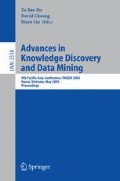Abstract
In this paper we introduce Self-Organizing Map-based techniques that can reveal structural cluster changes in two related data sets from different time periods in a way that can explain the new result in relation to the previous one. These techniques are demonstrated using a real-world data set from the World Development Indicators database maintained by the World Bank. The results verify that the methods are capable of revealing changes in cluster strucure and membership, corresponding to known changes in economic fortunes of countries.
Access this chapter
Tax calculation will be finalised at checkout
Purchases are for personal use only
Preview
Unable to display preview. Download preview PDF.
References
Fayyad, U.: Data mining grand challenges. In: Dai, H., Srikant, R., Zhang, C. (eds.) PAKDD 2004. LNCS (LNAI), vol. 3056, p. 2(keynote speech). Springer, Heidelberg (2004)
Guralnik, V., Srivastava, J.: Event detection from time series data. In: Proceedings of the fifth ACM SIGKDD international conference on Knowledge discovery and data mining, pp. 33–42. ACM Press, New York (1999)
Yamanishi, K., Takeuchi, J.: A unifying framework for detecting outliers and change points from non-stationary time series data. In: Proceedings of the eighth ACM SIGKDD international conference on Knowledge discovery and data mining, pp. 676–681. ACM Press, New York (2002)
Ganti, V., Gehrke, J., Ramakrishnan, R.: A framework for measuring changes in data characteristics. In: Proceedings of the Eighteenth ACM SIGACT-SIGMOD-SIGART Symposium on Principles of Database Systems, Philadelphia, Pennsylvania, May 31 - June 2, pp. 126–137. ACM Press, New York (1999)
Dong, G., Li, J.: Efficient mining of emerging patterns: discovering trends and differences. In: Proceedings of the fifth ACM SIGKDD international conference on Knowledge discovery and data mining, pp. 43–52. ACM Press, New York (1999)
Liu, B., Hsu, W., Han, H.S., Xia, Y.: Mining changes for real-life applications. In: Kambayashi, Y., Mohania, M., Tjoa, A.M. (eds.) DaWaK 2000. LNCS, vol. 1874, pp. 337–346. Springer, Heidelberg (2000)
Kaski, S., Lagus, K.: Comparing Self-Organizing Maps. In: Vorbrüggen, J.C., von Seelen, W., Sendhoff, B. (eds.) ICANN 1996. LNCS, vol. 1112, pp. 809–814. Springer, Heidelberg (1996)
Vesanto, J.: SOM-based data visualization methods. Intelligent Data Analysis 3, 111–126 (1999)
Kohonen, T.: Self-organized formation of topologically correct feature maps. Biological Cybernetics 43, 59–69 (1982)
Kohonen, T.: Self-Organizing Maps. Springer Series in Information Sciences (3rd edn. 2001), vol. 30. Springer, Heidelberg (2001)
Dolnicar, S.: The use of neural networks in marketing: market segmentation with self organising feature maps. In: Proceedings of WSOM 1997, Workshop on Self-Organizing Maps, Helsinki University of Technology, Neural Networks Research Centre, Espoo, Finland, June 4–6, pp. 38–43 (1997)
Vesanto, J., Alhoniemi, E.: Clustering of the Self-Organizing Map. IEEE Transactions on Neural Networks 11, 586–600 (2000)
Davies, D.L., Bouldin, D.W.: A cluster separation measure. IEEE Transactions on Pattern Analysis and Machine Intelligence 1, 224–227 (1979)
Denny: Visualizations of cluster changes by comparing self-organizing maps. Master’s minor thesis, School of Computer Science and Software Engineering, Monash University, 900 Dandenong Road Caulfield, Victoria 3145, Australia (2004)
Kaski, S., Kohonen, T.: Structures of welfare and poverty in the world discovered by the Self-Organizing Map. Report A24, Helsinki University of Technology, Faculty of Information Technology, Laboratory of Computer and Information Science, Espoo, Finland (1995)
Altbach, E.: Growth and regional integration in Latin America: will Japan miss the boat? Report 41, Japan Economic Institute (JEI), Washington, DC (1998)
Author information
Authors and Affiliations
Editor information
Editors and Affiliations
Rights and permissions
Copyright information
© 2005 Springer-Verlag Berlin Heidelberg
About this paper
Cite this paper
Denny, Squire, D.M. (2005). Visualization of Cluster Changes by Comparing Self-organizing Maps. In: Ho, T.B., Cheung, D., Liu, H. (eds) Advances in Knowledge Discovery and Data Mining. PAKDD 2005. Lecture Notes in Computer Science(), vol 3518. Springer, Berlin, Heidelberg. https://doi.org/10.1007/11430919_48
Download citation
DOI: https://doi.org/10.1007/11430919_48
Publisher Name: Springer, Berlin, Heidelberg
Print ISBN: 978-3-540-26076-9
Online ISBN: 978-3-540-31935-1
eBook Packages: Computer ScienceComputer Science (R0)

